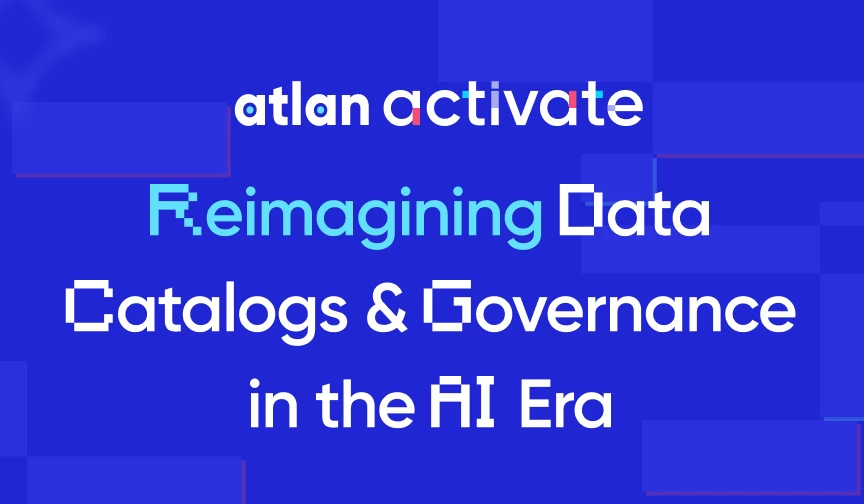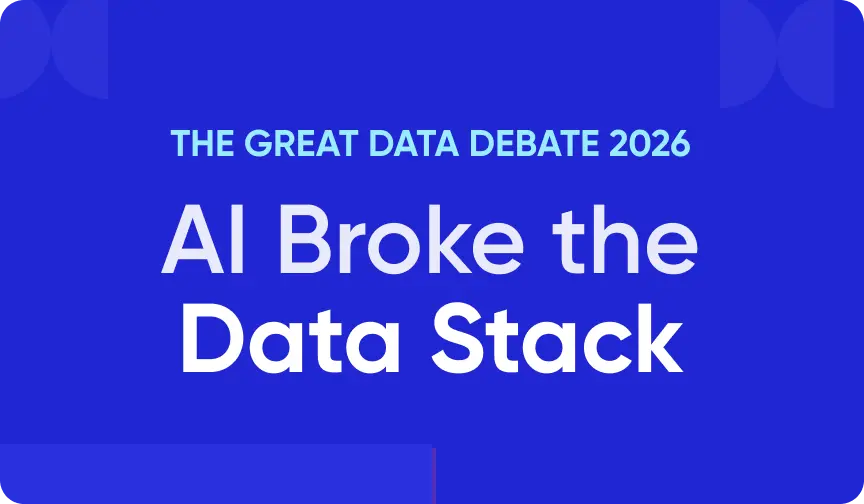Metadata-driven Data Quality Explained
Share this article
Data quality is critical to data systems: achieving a high level of data accuracy, consistency, completeness, and reliability builds trust among an organization’s data users. Metadata is a tool for providing essential context to data, like origin, structure, and how it connects to other datasets, systems, or processes. By understanding the relationship between metadata and data quality, you can create a more valuable and efficient data ecosystem.
See How Atlan Simplifies Data Governance ✨ – Start Product Tour
This guide explores this crucial connection, walks you through metadata strategies focused on data quality, and introduces the tools needed to support effective metadata management throughout your organization.
Table of Contents
Permalink to “Table of Contents”- What is metadata?
- How metadata supports data quality
- How to develop quality data with metadata
- Tools for metadata development
- Conclusion
- FAQs About metadata-driven data quality
- Related reads
What is metadata?
Permalink to “What is metadata?”Metadata is a system of tags attached to data objects that describe the object and provide context for data users. Metadata tags can include anything from the full spectrum of data information that serves your organization’s needs — things like last modification date and time, original project context, text description of object purpose, and privacy level. It can also indicate any transformations applied to the data, including calculations, aggregations, or cleaning procedures.
There is no definitive list of necessary metadata. The nature of a project’s metadata depends on data system structure, organizational goals, and broader requirements like regulation compliance. For instance, you might track ingest timestamps for security purposes, department labels for ownership tracking and organization, and use-case descriptions to improve communication and understanding.
How metadata supports data quality
Permalink to “How metadata supports data quality”Because metadata provides information about the data itself, it is particularly valuable during data quality investigations. It can, for example, help you understand why data quality issues are arising, specify data ownership to delegate responsibility, and identify data for specific quality enforcement.
Example: Using metadata to solve reporting discrepancies
Permalink to “Example: Using metadata to solve reporting discrepancies”A financial services company is experiencing inconsistencies in their quarterly revenue reports. Different departments are reporting conflicting numbers, causing confusion and raising concerns about the reliability of financial forecasts. For the data team, metadata is a powerful tool for investigating this data quality issue and finding a solution
Using metadata to find the data quality problem
Permalink to “Using metadata to find the data quality problem”When investigating this issue, the data team uses metadata to discover that:
- Source information metadata reveals that the sales department’s revenue data comes from the CRM system, while the finance department’s data comes from the ERP system.
- Processing history metadata shows that the sales data undergoes transformation in a data pipeline that was modified 3 months ago, but this change wasn’t documented properly.
- Timestamp metadata indicates that the finance system updates daily at midnight, while the sales system updates in real-time.
- Data ownership metadata shows that three different teams have been making independent changes to the revenue calculation rules.
Creating a Solution with Metadata
Permalink to “Creating a Solution with Metadata”With these insights, the company implements a number of metadata-driven data quality improvement solutions:
- They establish a data lineage framework that documents the complete journey of revenue data across systems, making transformations visible to all stakeholders.
- They implement standardized data definitions in a data dictionary, ensuring “revenue” means the same thing across all departments.
- They create data quality policies that specify validation criteria and related metadata tags for revenue figures before they can be used in reports.
- They name data stewards responsible for data quality, governance, and ensuring compliance across the organization.
- At the team level, they assign data ownership responsibilities for specific team members, putting them in charge of maintaining data quality, including descriptive and consistent metadata usage, in each system.
- They set up automated data lineage processes that flag discrepancies between systems based on metadata-defined thresholds.
By leveraging metadata to both identify and resolve the issue, the company establishes a single source of truth for revenue reporting and builds confidence in their financial data.
How to develop quality data with metadata
Permalink to “How to develop quality data with metadata”Every organization’s metadata strategy will be different, but there are a few general principles you can use when designing your metadata with quality in mind.
Specify dimensions of quality
Permalink to “Specify dimensions of quality”Data quality has six main dimensions – accuracy, completeness, consistency, timeliness, validity, and uniqueness.
Every use case relies on different quality dimensions. For instance, accuracy is crucial in research and medicine for obvious reasons; completeness is critical in finance, where an incorrect or missing account can be disastrous; consistency is necessary for proper case research using legal data.
To start building quality-focused metadata, consider which data quality dimensions matter most to your organization’s initiatives, and identify the information that could bolster these dimensions. For instance, you could tag a “missing records” count computation to all your financial assets, setting a quality flag triggered off the tag value.
Focus on data context that’s meaningful to your users
Permalink to “Focus on data context that’s meaningful to your users”Metadata exists to inform data users, so build your metadata strategy with user experience in mind. Ask yourself, What do our teams need to know about the data they encounter?
One approach to meaningful metadata is problem-solving: think about current or past data quality issues you’ve had, and build a tagging strategy that helps resolve that issue. For example, if you have been having formatting conflicts, create formatting tags to standardize data types and schema for your different data pipelines.
Align metadata quality strategy with organizational goals
Permalink to “Align metadata quality strategy with organizational goals”Data quality standards should drive data value. You don’t want to invest time and technology into maintaining standards that aren’t delivering results.
Your metadata strategy should follow the same principle. Ask yourself, What information would move us closer to our targets? For example, if you are making a push for customer engagement, adding budget or project metadata to marketing assets can help you assess ROI on your different initiatives.
Plan implementation phases
Permalink to “Plan implementation phases”Metadata implementation is often a complex and involved process. Teams have to adjust their daily workflows to accommodate new strategies. If you hit them with a wall of policies they may get frustrated and disengage, undermining your initiative.
That is why an effective metadata strategy is more than system design; it also includes implementation phases to ease teams into the new paradigm. You could go team by team, dimension by dimension, or pipeline by pipeline. Whatever your approach, start with your key areas and iterate, optimizing the impact of your current phase before moving to the next area.
Tools for metadata development
Permalink to “Tools for metadata development”There are four main types of tools for data-quality-focused metadata development.
- Data catalog - Data catalogs let you attach metadata to assets and track associated metadata. Search features let you browse your assets by data features and tags. Data catalogs are a necessary part of any metadata system.
- Monitoring tools - Monitoring tools track metrics associated with data quality standards. They can be SQL views, test queries, or third-party tools. Automated monitoring can flag quality issues as soon as they arise.
- Data governance and policy system - Data governance and policy tools collect and enforce data standards. Automated enforcement maintains your data quality standards at scale.
- Data sharing tools - Data sharing systems let your teams share data assets including the context provided by metadata. Having context embedded in your communications enables collaboration and improves understanding.
Atlan for metadata
Permalink to “Atlan for metadata”Atlan is valuable for metadata-driven data quality because it acts as a centralized platform to collect, manage, and visualize metadata from various data sources, allowing users to easily identify potential data quality issues by tracing data lineage, understanding data relationships, and proactively monitoring data quality metrics, all within a single interface, enabling faster detection and resolution of problems.
As a metadata platform designed to cater to the needs of data-driven teams, Atlan unifies metadata from diverse sources such as Snowflake, dbt, Databricks, Looker, Tableau, Postgres and others, consolidating them into a single source of truth for data discovery, cataloging, lineage, and governance.
Atlan’s third-gen data catalog uses AI-powered active metadata management to enhance your metadata strategy. Atlan’s policy and governance tools leverage metadata to develop and enforce quality standards at scale. Embedded collaboration tools let you integrate data sharing into your day-to-day workflows with metadata providing context for clear communication.
Conclusion
Permalink to “Conclusion”Metadata provides valuable context for understanding data, supporting focused and value-driven data quality standards. Developing a metadata strategy that supports key quality dimensions, provides meaningful context, and aligns with organizational goals leads to more robust and impactful data quality initiatives.
Atlan’s third-generation data catalog provides AI-powered active metadata management, policy enforcement, and embedded collaboration to support your metadata-driven data quality efforts. See what Atlan can do for your data quality development by booking a demo today.
FAQs About metadata-driven data quality
Permalink to “FAQs About metadata-driven data quality”What is metadata?
Permalink to “What is metadata?”Metadata is data that provides information about other data. It includes details such as the source, format, context, and relationships of data, helping users understand and effectively utilize data assets.
How does metadata support data quality?
Permalink to “How does metadata support data quality?”Metadata offers insights into data lineage, transformation processes, and ownership, enabling organizations to trace and resolve data quality issues. It aids in identifying discrepancies, ensuring consistency, and enforcing data governance policies.
What are the key dimensions of data quality?
Permalink to “What are the key dimensions of data quality?”The six main dimensions of data quality are accuracy, completeness, consistency, timeliness, validity, and uniqueness. Each dimension addresses different aspects of data quality, and their importance varies depending on the specific use case and organizational needs.
How can organizations develop quality data using metadata?
Permalink to “How can organizations develop quality data using metadata?”Organizations can develop quality data by specifying relevant quality dimensions, focusing on meaningful data context, aligning metadata strategies with organizational goals, and implementing phased approaches for metadata implementation. This involves defining quality metrics, standardizing data definitions, and ensuring that metadata provides valuable context to data users.
What tools are available for metadata development?
Permalink to “What tools are available for metadata development?”Several tools assist in metadata development, including data catalogs, monitoring tools, data governance systems, and data sharing platforms. These tools help in managing metadata, enforcing data quality standards, and facilitating collaboration among data teams.
Metadata-driven data quality: Related reads
Permalink to “Metadata-driven data quality: Related reads”- How to Improve Data Quality in 10 Actionable Steps?
- Data Quality Measures: Best Practices to Implement
- Data Quality in Data Governance: The Crucial Link that Ensures Data Accuracy and Integrity
- 6 Popular Open Source Data Quality Tools in 2025: Overview, Features & Resources
- Data Quality Metrics: Understand How to Monitor the Health of Your Data Estate
- How to Ensure Data Quality in Healthcare Data: Best Practices and Key Considerations
- Is Atlan compatible with data quality tools?
- Modern Data Platform 2025: Components, Tools & Benefits
- Data Quality Issues: Steps to Assess and Resolve Effectively
- What is Data Integrity and Why is It Important? - Atlan
- Data Transformation: Definition, Process, Examples & Tools
- Data Profiling: Definition, Techniques, Process & Examples
- What is Metadata Lineage & Why You Should Care About It?
- Data Lineage & Data Observability: Why Are They Important?
- Data Lineage Tools: Critical Features, Use Cases & Innovations (2025)
Share this article





















